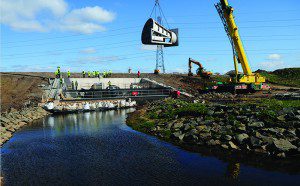
Flood technology experts have welcomed Government proposals to work with farmers to create more flood storage areas upstream, protecting downstream properties vulnerable to flash river flooding. At the start of this year, it was reported that providing positive rewards for farmers for managing temporary flood storage areas upstream of vulnerable areas could be encouraged as part of a review of flood defence thinking.
Alex Stephenson, chair of the British Water Sustainable Water Management Focus Group and group market development director of Hydro International explains why he would be in favour of such a measure.
FLASH river floods have been one of the most powerful, and often all-too-sudden, consequences of relentless rainfall in vulnerable low-lying areas in different parts of Britain in recent weeks.
The value of holding back the river water upstream, well away from vulnerable homes and businesses, in upstream flood storage defences is already a well-proven and sustainable alternative that combines the best of precision engineering and the natural environment.
It makes a lot more sense than just building higher and higher walls, flood gates and levees in the valleys and hoping that the surging river will not overtop them – especially as climate change makes such intense storm events more likely.
The White Cart Water, a tributary of the River Clyde, is a river prone to flash flooding. Before an innovative upstream flood storage scheme using Hydro-Brake® flow control technology was completed in 2012, the river had caused flooding misery in an area of South Glasgow 20 times since 1908.
One of the most memorable was at Hogmanay 1984 when 500 homes were inundated and millions of pounds of damage caused.
At the time of planning the White Cart scheme, it was recognised that just building defences along the river’s urban banks alone would have required flood walls over two metres high, which would have been a hugely disruptive construction project and have closed down the natural river system in the some places.
Instead, three upstream flood storage areas were constructed on agricultural land in the highlands above Glasgow with a capacity to hold up to 571 million gallons of flood water.
At the same time they provided 90,000m2 of wetland habitats. As part of the scheme design, plans were made to enhance biodiversity and wildlife habitat of the area with the creation of woodland, scrub, and species-rich wet grasslands, shallow scrapes and ponds and other artificial habitats.
The flood storage is held back by three dams using Hydro-Brake® Flood Alleviation vortex flow controls, which can be designed to precisely calculate the capacity and reach of upstream storage areas.
While the Glasgow scheme is the largest, housing the world’s largest Hydro-Brake® Flow Controls, many other smaller schemes around the country are using the same principle to hold back river and watercourse flooding successfully.
One of the biggest advantages of the cone-shaped vortex flow control technology is that it comes into operation automatically as the river levels rise.
There is no power needed, no-one needs to be there to operate the flood defence in an emergency, and there are no moving parts or electrical systems that could fail.
Another advantage is that the custom design and performance characteristic of the Hydro-Brake® Flood Alleviation flow control can reduce the volume of flood water to be stored by up to 30% compared to fixed orifice controls; reducing land take during storm events.
Hydro-Brake® flow controls have been installed in a flood alleviation scheme at Northallerton, North Yorkshire.
They enable excess water to be held back in specially built flood storage basins in agricultural land on the outskirts of the town, protecting 170 properties.
A scheme in the valley of the River Douglas in Wigan protects 610 properties from flooding in the nearby city centre.
Smaller communities from 70 to 300 homes have also benefited, for example at Portpatrick, Argyllshire, once devastated by flash floods through its streets, Weedon Bec in Northants and Devil’s Bridge near Sheffield.








